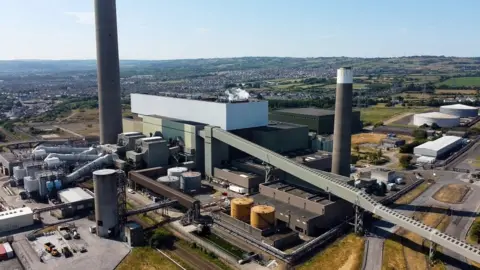Kilroot: 'Electricity disruption unlikely' as power station closes
 Getty Images
Getty ImagesThe company which operates the electricity grid in Northern Ireland says it does not expect any disruption to supply this winter despite the closure of the last coal fired power station.
Kilroot power station will stop generating electricity from coal at midnight on Saturday.
A replacement gas-fired station is under construction on the same site.
But it is not due to begin operation for at least three months.
It could even be as late as the end of March 2024.
Until now coal has made up about 15% of the electricity generated in Northern Ireland.
It is being phased out in order to decarbonise the electricity industry and meet new targets on Climate Change.
Concerns about transition
John Barry, professor of green political economy in the Centre for Sustainablity, Equality and Climate Action at Queen's University is no fan of coal power, but he does have some concerns about the way that the transition is being managed.
"In terms of fossil fuels coal is the absolute worst in terms of greenhouse gas emissions so we have to phase out coal as quickly and as equitably as we can," he said.
"So yes the Kilroot station moving from coal fired units to gas is a good news story, but of course there's going to be a gap and that's the issue."
Managing that gap is the job of the System Operator Northern Ireland (SONI).
It runs the grid in Northern Ireland and has to make up the 15% that used to be generated from coal.
Prof Barry is keen that it succeeds, because any power outages could damage public support and confidence in the switch to renewable energy.
"So we have the Moyle interconnector to Scotland but will that hold up? We had problems with it in 2017 when it was down for months and it was reduced by half its capacity," he said.
"The North-South interconnectors aren't up and running at speed yet either so there is a genuine issue."
Managing the change
In order to make the grid more secure, SONI has identified a number of essential measures:
• Bringing forward new generating capacity.
• Improving the grid connection between Northern Ireland and the Republic.
• Ensuring that new gas-fired power stations can operate without restriction on their running hours
Those things are happening, but not until 2024, 2025 and 2026 respectively.
By contrast, in the Republic of Ireland in March, Environment Minister and Green Party TD (MP) Eamon Ryan stood up in the Dáil (lower house of parliament) to bring forward emergency legislation to allow construction of two rapid start, gas fired power stations to keep the lights on this winter.
'Slightly more risk'
Alan Campbell, chief executive of SONI, said while the pressure on the system is greater this year than in previous winters he was confident that the grid in Northern Ireland had enough generating capacity, even before the new gas fired power station at Kilroot comes on line.
"There is slightly more risk this year, definitely," he said.
"And we're on record saying that. Particularly in terms of the new generation coming on stream.
"Can I ever put guarantees that the lights will never go out? No I can't.
"No system operator would ever say that. But we manage that risk."
Tom Bains, CEO of EPUKI, which owns Kilroot power station, said his company's focus "remains on progressing the transition from coal to new lower carbon gas generation on the site".
"We are continuing to work at pace on the construction of the Open Cycle Gas Turbine (OCGT) units and EPUKI remains committed to investing over £1bn in the Kilroot Energy Park site, building on the £250m which has been invested to date."
"Our plans for Kilroot represent the largest private sector investment in electricity generation on a single site, in Northern Ireland."

Analysis: How can Northern Ireland keep the lights on?
Northern Ireland has sufficient conventional generation.
If the wind is not blowing we can keep the lights on.
If all that generation is available to us we do not have a problem.
We can import a lot of power from Scotland and Ireland.
We work with counterparts in Great Britain all the time and they are more comfortable this winter in terms of their capacity, which means that we are slightly more comfortable with the risks.
The grid is changing, from being a distributor of electricity, taking power from a handful of large generating stations out to domestic and business customers, to something much more flexible, managing a more diverse portfolio of smaller generating and storage assets such as wind, solar and battery storage.
